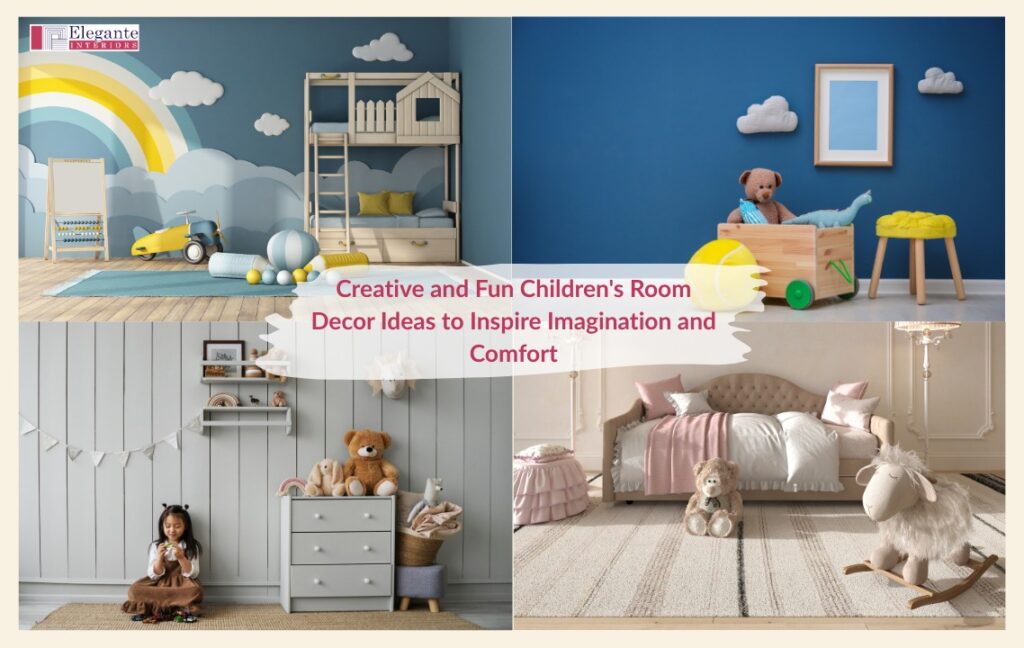Decorating a child’s room is a unique opportunity to blend creativity, comfort, and functionality into a space that nurtures their growth and imagination. Whether it’s a nursery for a newborn or a vibrant bedroom for a growing toddler or school-age child, children’s room decor can transform a simple room into a magical retreat that reflects their personality and needs. The key is to balance playful elements with practical design, so the space remains enjoyable, safe, and organized.
In this blog, we will explore a variety of children’s room decor ideas that inspire fun and foster a sense of security and creativity. From selecting the right color palettes and themes to choosing furniture and storage options, these tips will help you craft a room that your child will love spending time in.
Table of Contents
ToggleCreative and Fun Children’s Room Decor Ideas to Inspire Imagination and Comfort
Designing a child’s room is more than just picking cute furniture, it’s about creating a space where imagination can run wild and comfort is always close by. From playful wall art and cozy reading nooks to themed décor and DIY touches, the right elements can turn a simple room into a world of wonder. Whether you’re decorating for a toddler or a curious young explorer, the goal is to blend creativity with functionality. In this blog, we’ll explore inspiring children’s room decor ideas that not only spark imagination but also make kids feel safe, happy, and right at home.
Choosing the Perfect Theme and Colors
Selecting a theme is often the first step in children’s room decor, as it sets the tone and guides other choices. Popular themes range from whimsical fairy tales and nature-inspired settings to space exploration or favorite storybook characters. Opting for a neutral base with pops of color is another versatile choice that allows flexibility as the child grows.
Colors play a vital role in influencing mood and energy. Soft pastels create a calm atmosphere perfect for rest, while bright primary colors stimulate playfulness and creativity. Consider washable, non-toxic paint and wallpapers that are durable and safe. Mixing patterns with solids and using decals or murals can add interest without overwhelming the senses.
Furniture: Combining Comfort and Functionality
Choosing the right furniture is crucial for creating a comfortable and practical children’s room. Beds with built-in storage, bunk beds for siblings, or convertible cribs for infants growing into toddlers are excellent space-saving solutions. A cozy reading nook with a small chair or bean bag encourages quiet time and fosters a love for books.
Desks or activity tables tailored to a child’s size support homework and creative projects. Open shelving and modular storage units allow easy access to toys and books, promoting independence and tidiness. Safety is paramount, so opt for rounded edges and secure anchoring to prevent accidents.
Lighting to Set the Right Mood
Lighting influences both the function and feel of a child’s room. Natural light should be maximized during the day to create a cheerful environment. For evenings, soft ambient lighting is ideal to help children wind down and feel safe. Night lights with fun shapes or soft glows provide comfort to little ones afraid of the dark.
Task lighting at desks or reading corners ensures proper illumination for activities, while dimmable fixtures allow parents to adjust brightness according to needs. Consider eco-friendly LED bulbs for energy efficiency and longer life.
Playful and Educational Accessories
Accessories complete the childrens room decor by adding personality and learning opportunities. Wall art featuring alphabets, numbers, or world maps can be both decorative and educational. Interactive elements like chalkboard walls or magnetic boards encourage creativity and participation.
Textiles such as themed bedding, curtains, and rugs add warmth and tie the room’s look together. Including soft toys, puzzles, and sensory play items makes the room a joyful space to explore and grow.
Organization: Keeping the Room Tidy
A well-organized children’s room is essential for safety and ease of use. Incorporate labeled bins, baskets, and drawer dividers to categorize toys and supplies. Low shelves and hooks at child height enable kids to participate in cleanup routines.
Multipurpose furniture with hidden compartments keeps clutter out of sight. Rotating toys periodically helps maintain interest without overwhelming the space. Teaching children about organization through fun systems instills good habits early on.
Creating Zones for Different Activities
Designing specific zones within the room helps manage space and activity flow. A sleeping zone with the bed and nightstand fosters rest. A study or craft area with a desk and supplies supports learning and creativity. A play zone with ample floor space and accessible toys encourages movement and fun.Clearly defined zones can reduce distractions and help children transition smoothly between activities. Using rugs, furniture placement, or color accents distinguishes these areas visually and functionally.
Safety Considerations in Children’s Room Decor
Safety is a foundational aspect of any children’s room decor plan. Secure heavy furniture to walls to prevent tipping. Use cordless window treatments to avoid choking hazards. Choose non-toxic materials and finishes, and ensure electrical outlets are covered. Soft flooring options such as cushioned rugs or foam tiles can prevent injuries during play. Maintain good ventilation and regulate temperature to create a healthy environment. Regularly inspect toys and decor for wear and damage to maintain safety standards.
Frequently Asked Questions (FAQ)
Q: What are some budget-friendly childrens room decor ideas?
A: Use removable wall decals instead of paint, DIY simple shelves, and repurpose furniture. Focus on versatile basics and add fun accessories like cushions and rugs that can be updated as the child grows.
Q: How can I make a small childrens room feel larger?
A: Use light colors, multi-functional furniture with storage, and keep decor minimal. Mirrors and good lighting can visually expand the space. Vertical storage helps keep floor space clear for play.
Q: What are safe materials to use in childrens room decor?
A: Choose non-toxic paints and finishes, natural fabrics like cotton or wool, and furniture with rounded edges. Avoid small decor items that can be choking hazards for younger children.
Q: How do I choose a theme for my child’s room?
A: Consider your child’s interests and age, but keep flexibility in mind so the room can evolve. Neutral bases with themed accessories allow easy updates without major renovations.
Q: How often should I update my childrens room decor?
A: Update decor based on your child’s developmental stages and preferences. Typically, every 2-3 years is a good timeframe, but small seasonal or interest-based changes can happen more frequently.
Conclusion
Designing a child’s room is a rewarding challenge that combines imagination, comfort, and practicality. Thoughtful children’s room decor nurtures a child’s development by creating a space that is safe, inspiring, and functional. Whether you choose a bold theme, soft colors, or multi-functional furniture, the goal is to craft an environment where your child can learn, play, rest, and grow happily. By blending creativity with smart design, you give your child a room that truly feels like their own special world.
📞 Contact us for a free consultation or visit eleganteinterior.com to explore our portfolio!





